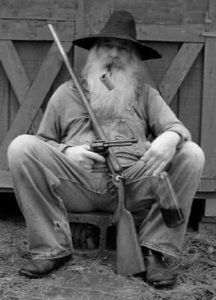When people complain to me about transcription errors in our shiny new databases, I try to reassure them: “Notch your scepticism up to 11, come at the records from as many angles as possible and always remember that these errors are the price you pay for having the databases in the first place.”
Going through the National Archives online Tithe Books collection over the past week, I repeated that advice to myself over and over, but it didn’t work. I just don’t want to pay that price any more.

As a source, the Books’ main virtue is that they exist. If we had the censuses destroyed in 1922, they’d be a quirky footnote, a textbook example of blinkered Irish sectarianism shooting itself in the foot. Supporting your clergy by imposing a tax on near-destitute members of a rival church was hardly a recipe for inter-faith harmony.
But they are now virtually the only census substitutes for most places in the 1820s and 1830s, and the NAI online collection is the only route of access. And it’s god-awful.
First, the quality of the personal name and place name transcriptions is only wojus. In a single parish, Knock in Mayo, I’ve counted at least ten mistakes for the surname Flatley: Flattey, Hattley, Halley, Hattely, Hatley, Huttley, Slatterly, Slattery, Thally, and Harley.

OK, but at least we can use the online images as if we were at a microfilm reader and just ignore the database?
No. The parish names are jumbled up so badly, it’s impossible to be sure what images you’re looking at. To take Carlow alone, the link for Aghade takes you to Aghada (Kerry), Clonmelsh to Clonmult (Cork), Lorum to Loughbraccan (Meath), Painestown (Carlow) to Painstown (Meath) … And the online correction facility provides no way of pointing out gross navigational problems like these.
Then last week, while wandering idly through the FamilySearch online catalogue, I came across the listing for the original microfilm collection on which the NAI site is based. The layout makes it clear that the originals were organised into 140 bundles alphabetised by parish name. So bundle #1 ran from Abbey to Aghaboy and bundle #140 from Wallstown to Youghalarra. (and incidentally bundle #45 Drung to Duncormick was never microfilmed at all and so is just not digitised).
All the mistaken parish identifications are there on FamilySearch too, but seeing the original microfilms laid out like this makes it possible to burrow down to the actual start point of each tithe book. I’ve done it for Carlow (here), but with the results linked to FamilySearch rather than NAI. For one thing, the FamilySearch online microfilm reader has previous/next links, praised be the Saints. For another, where there are database transcripts, they appear below the images, providing (limited) help in deciphering.
There’s a lot more work to be done to make the other 25 counties actually useable. I don’t think anyone else is going to do it.
You crack me up. 🙂
I am sure the Family Search microfilm with the previous/next choices were a blessing.
Thanks for all your hard work in simplifying for the family of researchers/genealogists research tools. Saves us a lot of headache.
Does that make sense?
Katrina
Thanks John. I feel better hearing this from an expert! I am so lost and confused ?most of the time that I close the books, shut down the computer, and start cleaning out junk drawers! ? I hate that job! But there are times when it is relaxing! Lol. ?
I was looking for John Melody in the Tithe Applotments last week for Grange, Galway and found it in Limerick. I didn’t realize it was a more wide-spread issue.
Thanks for this, John. It’s good to know that Family Search has the originals. It’s a lot easier to try to verify/confirm surnames with the originals. Incidentally, the writing is not too difficult to read either!
Thank you for your hard work!
There is a format error for the link to the National Archives online Tithe Books collection.
Thanks for pointing it out. Now fixed
I was busy searching the TAB on the NAtional Archives site for a family in Kinneigh / Kinneagh in County Cork with no luck. I eventually found them under Kinneagh, County Carlow. Just another example of their inaccuracies. One of those situations where local knowledge was another source to draw on having lived near both Kinneaghs.
However hard it might be for someone reared in Ireland used to Irish place names, it must be a real nightmare for those of Irish ancestry reared outside of Ireland to get a handle on the Tithe Books. Nice article John, well done.
Perfect example, John, of a job that’s in desperate need of being done again from stretch! ?
My grandmother Peg Ryan had the perfect answer to quandaries like this … “just go put the kettle on, sure it could be worse … ” ?
Is that photo of Marvin “Popcorn” Sutton from Tennessee?
Thank you for this insight, John. I didn’t realise they were so difficult to navigate! They were on my ‘to do’ list, but have now been relegated to a lower priority, until I can muster up some additional brain power!
Thank you so much for all you do John. As a Canadian with Irish ancestry on both paternal, and materal, lines your work is very much appreciated.
On the case of Knock I imagine part of reason for that is the parish would have been majority Irish speaking in the 1830’s (as was all of Mayo) — as result what we could be seeing is multiple different angliscations used by different households, only later did they assimilate to one standard angliscation etc.
There are lots of pages that are duplicates and some that appear to have the same person and section of land in two pieces. It’s not limited to tithe books thouogh. I looking at the will index for the diocese of Armagh I find a possible ancestor of mine in a townland that just doesn’t match the known spelling of any townland in Ireland. Also in The Carrickedmond church records poor Pat McGarrell and McGarl are either one person or Catherine Allen was a bigamist. That’s actually good news for me because that makes it likely that either spelling might be an ancestor. I guess we’re doomed to frustration. But I appreciate all the work that has gone into making records more readily available and also organizing them
Yes, indeed. In the Tithe Applotment records. Killallaghtan civil parish in Co Gawlay actually appears under Co. Mayo. That error lies in the original books, as I learned at family search.
Just an FYI for all researching St. Peter’s Co. Louth – The parish of St. Peter’s, Drogheda, Co. Louth was placed with the parish of St. Peter’s Athlone, Co. Roscommon and not available via the search on the National Archives website – Here is the link: http://titheapplotmentbooks.nationalarchives.ie/reels/tab//004625716/004625716_00494.pdf
You can scroll through the pages by changing the number 494.pdf to 495.pdf in the URL bar
Seems like arbitrary spellings and appalling transcriptions are everywhere in historical records. Wonder what folks will think of us in 200 years . . .
(By the way, I don’t believe the defensive gentleman in the photo is Popcorn Sutton–looks a little large and way too healthy.)
Yes when looking for Kindelan ancestors in Cavan I found Laraweehan (Lauravane) in Drumgoon County Cavan is indexed as Drumgooland County Down. Still not corrected despite me telling NAI and Familysearch numerous times
I can connect my family back to Clarcam in Donegal. The Tithe entry (Claar Cam) is at: http://titheapplotmentbooks.nationalarchives.ie/reels/tab//004587432/004587432_00010.pdf
Strangely, there is no breakdown of the individual holdings in this townland, making it difficult to match it up with the Griffith records in 1858. What does this omission mean? Did the landlord handle the tithes for the whole townland or is this a copy with some of the details missing?
The formats of Tithe Books are not standard and are very hard to link to Griffith’s. The Books were compiled by the local Church of Ireland clergy, whose only concern was who owed them how much. If there’s no breakdown of individual holdings, it just means everyone in the townland was liable for the amount and it was up to them to decide how they’d scrape it together.
Many thanks for the rapid reply John. I have been able to make links between some of those named in the Tithe and Griffith returns using parish records but keep hoping there is a bit more to be extracted from the Tithe description. Land occupied would have been very useful if available. The order of entry and occasional annotations seem to have some value but have given me nothing so far. I’ll document everything carefully to see if that helps! David